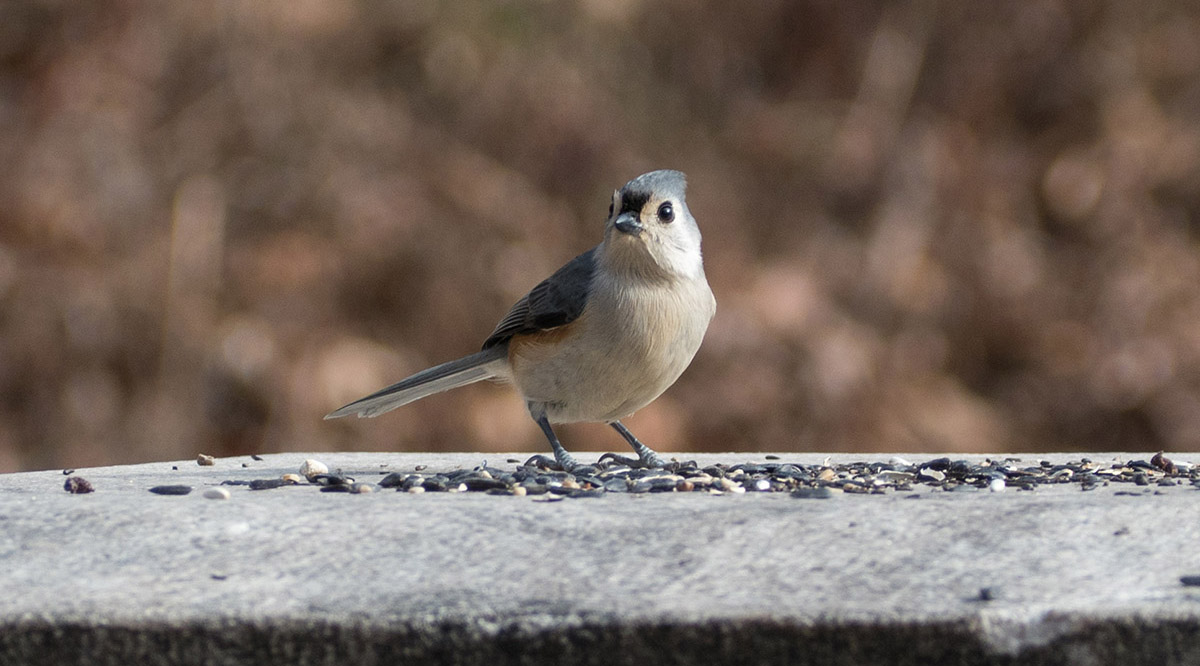Research suggests sentinel warning calls may be universally understood across continents

A tufted titmouse observing its surroundings. Titmice are one of North America's most common sentinel species. / Wikimedia
Animals often use vocalizations to warn of nearby danger to others. While this information is generally intended for members of the same species, other species can eavesdrop on the warnings to use the information for their own benefit. Sentinels are animals that have warning calls so widely understood by others that those other species will form groups with them, relying on the sentinels to provide warnings for danger. For example, the family Paridae, which are a group of birds that consist of chickadees, tits, and titmice, are known as sentinels because their alarm call for danger, which fittingly sounds like “chick-a-dee-dee-dee,” is understood by most other bird species in their mixed-species flocks.
“Many animals form mixed-species groups, and the thought is that this is an anti-predator behavior,” said Henry Pollock, Executive Director of the Southern Plains Land Trust. “There is safety in numbers, and there is a benefit to surrounding yourself with a more diverse set of eyes and ears. However, you have to be able to understand the information that the others around you give to make use of it.”
Sentinel calls are so readily understood as a signal for danger that researchers wondered whether species that have never heard the call would still get the message. After a recent study found that birds in the Neotropics were responsive to unfamiliar chickadee alarm calls from North America, researchers at the University of Illinois Urbana-Champaign wanted to expand on this. The team sought to test if bird communities across three different continents could understand calls for danger from a sentinel they had never encountered before – the dusky-throated antshrike. Antshrikes are birds widely distributed across Central and South America that often act as sentinels in their mixed-species flocks.
The study was spearheaded by Pollock and Jonah Dominguez, a graduate student in the Program in Ecology, Evolution, and Conservation, who conducted the experiments along with researchers in the lab of Mark Hauber (GNDP), a former professor of ecology, evolution, and behavior at the University of Illinois Urbana-Champaign, and collaborators from Serbia and China. The researchers presented playbacks of warning calls of the dusky-throated antshrike, along with warning calls of a local Paridae sentinel and controls, to flocks of wintering birds in North America, Europe, and Asia, and measured their behavioral responses.
The researchers predicted that birds on each continent would respond most strongly to the playback of their local sentinel since they were already familiar with the calls. However, the team was surprised to find that flocks were also highly responsive to the unfamiliar antshrike’s warning calls.
“We expected to see some kind of response to the novel antshrike’s calls, but predicted that birds wouldn’t respond as strongly to it as their own local sentinel’s calls,” said Dominguez. “However, we were surprised to find no statistical difference in how birds responded to the local versus foreign sentinel’s alarm call. Birds were responding to the unfamiliar antshrike’s call as if it was a bird they’ve known their whole lives.”
Flocks of birds across all three continents responded equally as strongly to the unfamiliar antshrike’s warning calls as they did to familiar, local sentinel’s warning calls. The researchers say this finding suggests there is something to sentinel calls that makes them so universally recognizable. For messages that contain important information, such as a warning call for danger, evolution likely converges on similar sounding calls that help get across the message as quickly as possible, according to the researchers.
“It’s possible that these calls are more readily recognized across species because they have a central theme – essentially something about them that is unique and conserved despite millions of years in evolutionary history,” explained Dominguez. “There is research in other animals on specific amplitudes and frequencies of sound that cause innate responses, even in animals that are unfamiliar with those sounds. Our study can help researchers figure out what those acoustic elements might be for birds.”
“What’s amazing is that our findings are consistent across three different continents with completely different bird communities, which suggests there is some signal encoded within these sentinel alarm calls that cause birds to respond to them, independent of previous experience with that signaler,” explained Pollock. “This really highlights that signal recognition is not always something that has to be learned through environmental experience.”
The team says the study opens the door to many future research directions to take. Testing birds with the calls of other sentinels and getting more granular in terms of the behavioral responses recorded are potential next steps, according to the researchers. Dominguez also plans to try to standardize what is categorized as a sentinel species across the literature, since it is currently not well established.
“Sentinel species are not very well defined, as the term is used nebulously for any animals that engage in mixed-species foraging and signaling,” said Dominguez. “There’s lots of birds that we don’t typically think of as sentinels being classified as them in the literature, and others that probably are sentinels that are being overlooked. I want to figure out if there’s a common thread between them, and whether the term should be used on the species level or more on a flock level.”
The study, which is published in Biology Letters, was funded by NSF, Illinois, the Ministry of Education, Science, and Technological Development of Serbia, and the Basic Scientific Research Projects of Liaoning Provincial Department of Education grant. The paper can be found at: https://doi.org/10.1098/rsbl.2023.0332

